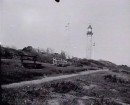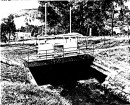MOUNTAIN CHIEF MINE SITE
HOWQUA TRACK HOWQUA, MANSFIELD SHIRE
-
Add to tour
You must log in to do that.
-
Share
-
Shortlist place
You must log in to do that.
- Download report
Statement of Significance
What is significant?
The Yackandandah Creek Gorge Gold Mining Diversion Sluice consists of a 65 metre long stone diversion sluice and associated pebble dumps, and a 200 metre long tail race. The embankment was used to divert the waters of Yackandandah Creek away from its natural bed which was then mined for its alluvial gold. The tailrace was cut in 1882 by the Premier Company when they sluiced Rowdy Flat.
How is it significant?
The Yackandandah Creek Gorge Gold Mining Diversion Sluice is of historical, archaeological and scientific importance to the State of Victoria.
Why is it significant?
The Yackandandah Creek Gorge Gold Mining Diversion Sluice is historically and scientifically important as a characteristic and well preserved example of two early forms of gold mining. Gold mining sites are of crucial importance for the pivotal role they have played since 1851 in the development of Victoria. Water diversion and sluicing are important key ingredients in an understanding of gold mining technology as it was employed in mountainous country where water was plentiful and perennial.
The Yackandandah Creek Gorge Gold Mining Diversion Sluice is archaeologically important for its potential to yield artefacts and evidence which will be able to provide significant information about the cultural history of gold mining and the gold seekers themselves.
[Source: Victorian Heritage Register]
-
-
MOUNTAIN CHIEF MINE SITE - History
Heritage Inventory History of Site:
The Mountain Chief - the first Howqua reef - was discovered in 1866, but little headway was made with the pyritic ore at that time. The reef was taken up and worked in earnest in 1882. After sample crushings yielded up to 14 oz per ton, the Mountain Chief Co. in 1883 erected a treatment plant costing £3,000. The (6-head?) battery was powered by water which was supplied by a race from Howqua River. The plant also included furnaces for treating the highly mineralised ore. The company worked the reef by an open cut on a spur south-west of Fry's Flat (between Sheepyard Flat and Fry's hut), but yields were poor and the mine closed in 1885.The Mountain Chief mine was again taken up early in the 1890s. The company reconditioned and utilised the battery of the Howqua United Co., lower down the ridge from the Mountain Chief mine, and erected (at a reputed cost of £8,000) a substantial roasting furnace and tall chimney beside the Howqua River at Fry's Flat in 1892. ) As before, the venture was shortlived and unsuccessful .
References:
Christie, pp. 32-4, 46
Flett, p. 110
Mining Surveyors' Reports (Jamieson Subdivision), September 1882
Wylie (1987), p. 44Heritage Inventory Description
MOUNTAIN CHIEF MINE SITE - Heritage Inventory Description
The features of the Mountain Chief mine sites are mine workings and a battery site.
Heritage Inventory Significance: National. The site has value as part of a network, with Howqua United/Great Rand mine site.
Heritage Inventory Key Components: Workings - Filled, slightly subsided shaft and small heap. The traces of the double-acting tramway from the Great Rand open cut runs over the top of the workings. On the side of the hill is an open adit with a 20m-long cutting. Battery site - Little sign survives of the 1883 Mountain Chief battery, except for excavated platform, largely buried wheel pit, tail race running to the river, and a water race on the ridge above.
Archeological Potential: Yes.
-
-
-
-
-
STOCKYARD CREEK GOLD MINING DIVERSION SLUICE
 Victorian Heritage Register H1255
Victorian Heritage Register H1255 -
STOCKYARD CREEK GOLD MINING DIVERSION SLUICE
 Victorian Heritage Inventory
Victorian Heritage Inventory -
MOUNTAIN CHIEF MINE SITE
 Victorian Heritage Inventory
Victorian Heritage Inventory
-
-






